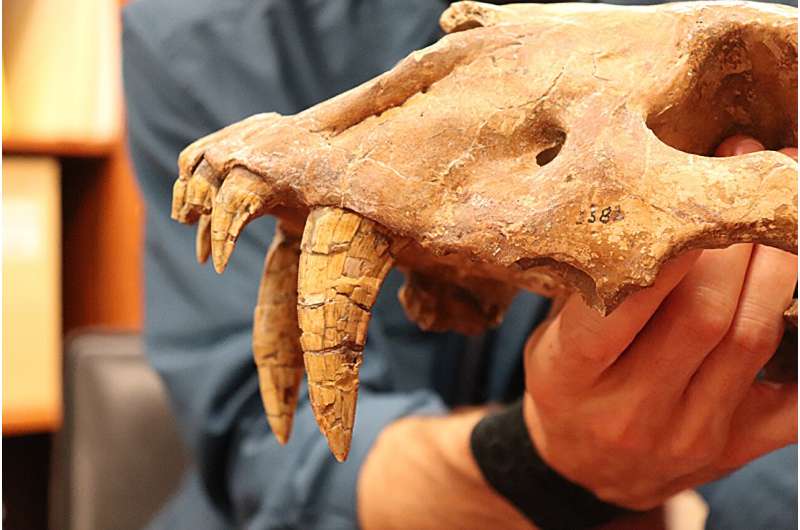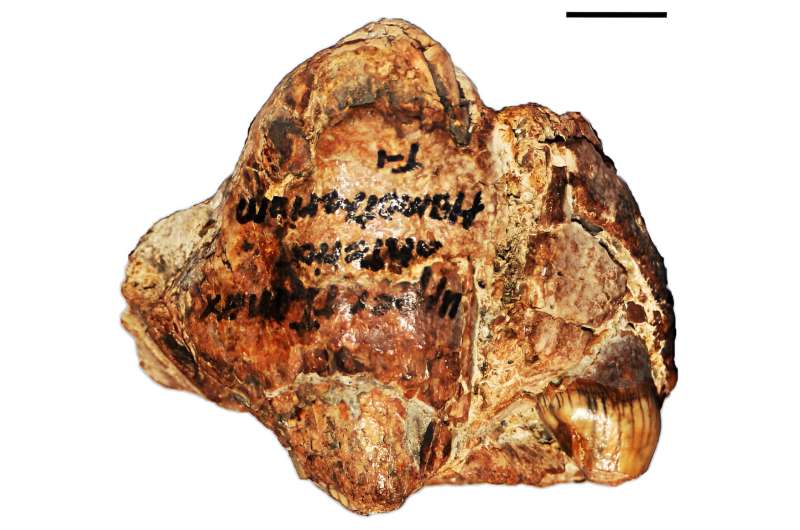This article has been reviewed according to Science X's editorial process and policies. Editors have highlighted the following attributes while ensuring the content's credibility:
fact-checked
trusted source
proofread
Fossil places extinct saber-toothed cat on Texas coast

Important scientific finds don't always come in the biggest, buzziest packages. Sometimes new discoveries come in little ugly rocks. Such is the case of a 6-centimeter-wide, nondescript mass of bone and teeth that helped a scientist at The University of Texas at Austin expand the geographic footprint of a large cat that roamed the Earth tens of thousands of years ago.
"You can't even tell what it is, let alone which animal it came from," said John Moretti, a doctoral student at the UT Jackson School of Geosciences who led the research. "It's like a geode. It's ugly on the outside, and the treasure is all inside."
The research was published in the May issue of The Anatomical Record.
The fossil looks like a lumpy, rounded rock with a couple of exposed teeth that are a little worse for wear, having been submerged and tumbled along the floor of the Gulf of Mexico for thousands of years before washing up on a beach. But when the fossil was X-rayed at the Jackson School's University of Texas Computed Tomography Lab, Moretti saw there was more to the fossil that met the eye: a hidden canine tooth that had not yet erupted from the jaw bone.
It was just what Moretti needed to identify the fossil as belonging to a Homotherium, a genus of large cat that roamed much of the Earth for millions of years. Because this specific cat wasn't fully grown when it died, its distinctive saber-like canine tooth had not fallen into its permanent position. Nestled inside the jaw, the tooth was protected from the elements.

"Had that saber tooth been all the way erupted and fully in its adult form, and not some awkward teenage in-between stage, it would have just snapped right off," Moretti said. "It wouldn't have been there, and we wouldn't have that to use as evidence."
Homotherium spanned across habitats in Africa, Eurasia and the Americas. It was a large, robust cat about the size of a jaguar, with an elongated face, lanky front legs, and a sloping back that ended in a bobtail. Their serrated canine teeth were covered by large gum flaps, similar to domestic dogs today.
Their fossils have been found in several areas of Texas, but this fossil shows for the first time that the big cat roamed the now-submerged continental shelf that connects Texas and Florida. Scientists hypothesize that this stretch of land was a Neotropical corridor. Animals such as capybaras and giant armadillos that wouldn't have ventured farther north used this strip of humid grassland to move from Mexico to Texas to Florida.
The discovery that Homotherium lived along this corridor gives scientists a small glimpse into the ecology of this landscape during the Late Pleistocene, Moretti said. Big carnivores such as these cats helped shape the broader animal community, tamping down prey-animal populations and influencing regional biodiversity.
The fossil specimen was discovered more than 60 years ago on McFaddin Beach, south of Beaumont, by Russell Long, a professor at Lamar University, but was donated by U.S. Rep. Brian Babin, a former student of Long's who worked for 38 years as a dentist. Babin said that his training in paleontology and dentistry helped him recognize that what seems like a strange rock at first glance is actually an upper jaw bone and teeth.
The research is part of a larger initiative on McFaddin Beach fossils started in 2018 by William Godwin, curator at the Sam Houston State University Natural Science Museum and a co-author of the study. Co-authors also include Deanna Flores, Christopher J. Bell, Adam Hartstone-Rose, and Patrick J. Lewis.
More information: John A. Moretti et al, The scimitar‐cat Homotherium from the submerged continental shelf of the Gulf Coast of Texas, The Anatomical Record (2024). DOI: 10.1002/ar.25461
Provided by University of Texas at Austin





















